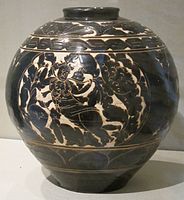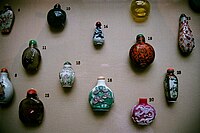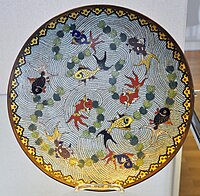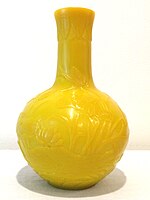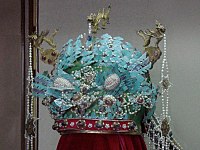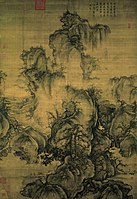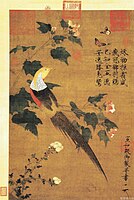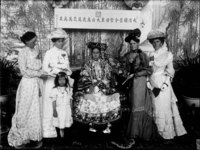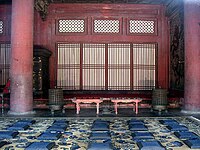
The National Palace Museum, is a museum in Taipei, Taiwan. It has a permanent collection of nearly 700,000 pieces of Chinese artifacts and artworks, many of which were moved from the Palace Museum in the Forbidden City in Beijing, as well as five other institutions throughout mainland China during the ROC retreat. These collections had been transferred to several locations before finally being established in 1965 at its present location in Shilin, Taipei. The museum building itself was built between March 1964 and August 1965, with many subsequent expansions making it one of the largest of its type in the world. There is also a Southern Branch in Taibao, Chiayi which opened in 2015.

Chinese art is visual art that originated in or is practiced in China, Greater China or by Chinese artists. Art created by Chinese residing outside of China can also be considered a part of Chinese art when it is based on or draws on Chinese culture, heritage, and history. Early "Stone Age art" dates back to 10,000 BC, mostly consisting of simple pottery and sculptures. After that period, Chinese art, like Chinese history, was typically classified by the succession of ruling dynasties of Chinese emperors, most of which lasted several hundred years. The Palace Museum in Beijing and the National Palace Museum in Taipei contains extensive collections of Chinese art.

Chinese culture is one of the world's oldest cultures, originating thousands of years ago. The culture prevails across a large geographical region in East Asia with Sinosphere in whole and is extremely diverse, with customs and traditions varying greatly between provinces, cities, and even towns. The terms 'China' and the geographical landmass of 'China' have shifted across the centuries, with the last name being the Great Qing, before the name 'China' became commonplace in modernity.

The Palace Museum is a large national museum complex housed in the Forbidden City at the core of Beijing, China. With 720,000 square metres, the museum inherited the imperial royal palaces from the Ming and Qing dynasties of China and opened to the public in 1925 after the last Emperor of China was evicted.

The Mukden Palace, or Shenyang Imperial Palace, was the former palace of the Later Jin dynasty and the early Qing dynasty. It was built in 1625, and the first three Qing emperors lived there from 1625 to 1644. Since the collapse of imperial rule in China, the palace has been converted to a museum that now lies in the center of Shenyang, Liaoning.

A ruyi is a Chinese curved decorative object that serves as either a ceremonial scepter in Chinese Buddhism or a talisman symbolizing power and good fortune in Chinese folklore. The "ruyi" image frequently appears as a motif in Asian art.

The Wanshou Temple is a temple located at No.121, Wanshousi Road, Zizhuyuan Subdistrict, Haidian District, Beijing. In addition to being a Buddhist temple, the Wanshou Temple also houses the Beijing Art Museum.

This carved lacquerware table in the Victoria and Albert Museum in London is from the Ming dynasty (1368–1644). It is unique in shape and decoration and is one of the most important objects from the period. It is one of the few surviving examples in the world of a major piece of furniture produced in the 'Orchard Workshop', the Imperial lacquer workshop set up in the early Ming period and situated to the north-west of the 'Forbidden City' compound in Peking.

The Hall of Mental Cultivation is a building in the inner courtyard of the Forbidden City in Beijing, China. The hall is a wooden structure with dome coffered ceilings, and was first built during the Ming dynasty in 1537, and was reconstructed during the Qing dynasty. During the early Qing dynasty under the reign of the Kangxi Emperor the hall was mostly used as a workshop, wherein artisan objects like clocks were designed and manufactured. From the reign of the Yongzheng Emperor during the 18th century, the hall was the residence for the emperor. Under the reign of the Qianlong Emperor until the fall of the Qing dynasty, the hall became the centre of governance and political administration. In the Western Warmth Chamber, the emperor would hold private meetings, and discuss state affairs with his mandarins. After the death of Emperor Xianfeng, from inside the Eastern Warmth Chamber, empress dowagers Ci'an and Cixi would hold audiences with ministers and rule from behind a silk screen curtain during their regencies for emperors Tongzhi and Guangxu, who both succeeded to the throne as children in the second half of the 19th century.

The Admonitions Scroll is a Chinese narrative painting on silk that is traditionally ascribed to Gu Kaizhi, but which modern scholarship regards as a 5th to 8th century work that may or may not be a copy of an original Jin dynasty (266–420) court painting by Gu. The full title of the painting is Admonitions of the Court Instructress. It was painted to illustrate a poetic text written in 292 by the poet-official Zhang Hua (232–300). The text itself was composed to reprimand Empress Jia (257–300) and to provide advice to the women in the imperial court. The painting illustrates this text with scenes depicting anecdotes about exemplary behaviour of historical palace ladies, as well as with more general scenes showing aspects of life as a palace lady.
Dragon robes, also known as gunlongpao or longpao for short, is a form of everyday clothing which had a Chinese dragon, called long (龍), as the main decoration; it was worn by the emperors of China. Dragon robes were also adopted by the rulers of neighbouring countries, such as Korea, Vietnam, and the Ryukyu Kingdom.

Hanfu are the traditional styles of clothing worn by the Han Chinese. There are several representative styles of hanfu, such as the ruqun, the aoqun, the beizi and the shenyi, and the shanku.
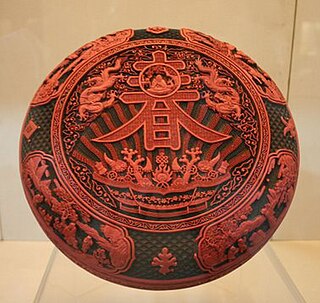
Carved lacquer or Qidiao is a distinctive Chinese form of decorated lacquerware. While lacquer has been used in China for at least 3,000 years, the technique of carving into very thick coatings of it appears to have been developed in the 12th century CE. It is extremely time-consuming to produce, and has always been a luxury product, essentially restricted to China, though imitated in Japanese lacquer in somewhat different styles. The producing process is called Diaoqi.

Handicrafts produced during the Qing dynasty (1644–1911) were objects designed and hand-made by craftsmen. They were heavily ornate, incorporating Tibetan, Middle Eastern, Indian, and European techniques. The design or decorative aspect of the craft was as important as the crafting technique itself and Qing artisans were particular about the materials they used, such as jade (yu), stones, and wood. In their designs artisans drew heavily from a number of motifs, both mythical and natural. Certain areas in China became well-known for specific types of handicrafts; for example, Jingdezhen was known as the capital of porcelain. During the Qing era, Imperial Workshops built in Beijing brought together artisans and raw materials that were once only obtainable in disparate regions. This allowed for the combining of technologies and materials to produce new types of handicrafts. The tributary system also brought new sources for materials and artisans that were not from the production centers.

Yunjian, also known as Cloud collar in English and sometimes referred as châr-qâb, is a Chinese term which can either to a four-lobed motif, or to a traditional Chinese garment accessory item in Hanfu, the Traditional clothing of the Han Chinese, which is typically found in the form of a detachable collar with cloud patterns and is worn over the shoulders area, similar to a shawl. As an garment accessory, the yunjian is also typically found in four-lobed design although multi-lobed design also existed throughout history. The yunjian could also be applied directly on garments, where it would fall around the collar of robes onto the chest and shoulder region,or as a clothing appliqué. In China, the yunjian has both ceremonial and practical uses when used in clothing. As a garment item, the yunjian was an important clothing element for Chinese women, especially in the Ming and Qing dynasties; its usage was spread across China where it became associated with the Han Chinese's wedding clothing. In Henan, brides would wear yunjian decorated with hanging ribbons and bells. It also had the practical use of preventing clothing from being dirty and oily by covering up the clothes and by covering up the stains. The yunjian is used in Peranakan wedding; the multi-layered yunjian worn by Chinese brides on the day of their wedding is sometimes known as "phoenix collar". The yunjian also started to be worn by the Non-Chinese, the Tartars of northern China and Manchuria in the later medieval period.
Mangfu, also known as mangpao, huayi, and python robe, sometimes referred as dragon robe although they are different garments, in English, is a type of paofu, a robe, in Hanfu. The mangfu falls under the broad category of mangyi, where the mangfu is considered as being the classic form of mangyi. The mangfu was characterized by the use of a python embroidery called mang although the python embroidery is not a python snake as defined in the English dictionary but a four-clawed Chinese dragon-like creature. The mangfu was derived from the longpao in order to differentiate monarchs and subjects; i.e. only the Emperor is allowed to wear the long, five-clawed dragon, while his subjects wears mang. The mangfu was worn in the Ming and Qing dynasties. They had special status among the Chinese court clothing as they were only second to the longpao. Moreover, their use were restricted, and they were part of a special category of clothing known as cifu, which could only be awarded by the Chinese Emperor in the Ming and Qing dynasties, becoming "a sign of imperial favour". People who were bestowed with mangfu could not exchange it with or gifted it to other people. They were worn by members of the imperial family below of crown prince, by military and civil officials, and by Official wives. As an official clothing, the mangfu were worn by officials during celebration occasions and ceremonial events. They could also be bestowed by the Emperor to people who performed extraordinary services to the empire as rewards, to the members of the Grand Secretariat and to prominent Daoist patriarchs, imperial physicians, tributary countries and local chiefs whose loyalty were considered crucial to secure the borders. The mangfu is also used as a form of xifu, theatrical costume, in Chinese opera, where it is typically found in the form of a round-necked robe, known as yuanlingpao. In Beijing opera, the mangfu used as xifu is known as Mang.

Qizhuang, also known as Manfu and commonly inappropriately referred as Manchu clothing in English, is the traditional clothing of the Manchu people. Qizhuang in the broad sense refers to the clothing system of the Manchu people, which includes their whole system of attire used for different occasions with varying degrees of formality. The term qizhuang can also be used to refer to a type of informal dress worn by Manchu women known as chenyi, which is a one-piece long robe with no slits on either sides. In the Manchu tradition, the outerwear of both men and women includes a full-length robe with a jacket or a vest while short coats and trousers are worn as inner garments.

Lishui or shuijiao is a set of parallel diagonal, multicoloured sea-waves/line patterns. It originated in China where it was used by the Qing dynasty court prior to the mid-18th century. Lishui represents the deep sea under which the ocean surges and waves; it is therefore typically topped with "still water", which is represented by concentric semicircle patterns which runs horizontally. Lishui was used to decorate garments, including the bottom hem and cuffs of some of the court clothing of the Qing dynasty. It could be used to decorate as wedding dress items. It is also used to decorate Chinese opera costumes, typically on the bottom hem of the costumes. It was also adopted in some court clothing of the Nguyen dynasty in Vietnam under the influence of the Qing dynasty.
Chinese auspicious ornaments in textile and clothing refers to any form of Chinese auspicious ornaments, which are used to decorate various forms of Chinese textile and clothing, fashion accessories, and footwear in China since the ancient times. Chinese auspicious ornaments form part of Chinese culture and hold symbolic meanings. In ancient China, auspicious ornaments were often either embroidered or woven into textile and clothing. They are also used on religious and ritual clothing and in Xifu, Chinese opera costumes. Auspicious symbols and motifs continue to be used in present day China in industries, such as home textiles and clothing; they are also used in modern design packaging and interior design. Some of these Chinese auspicious ornaments were also culturally appropriated by European countries during the era of Chinoiserie, where they became decorative patterns on fashionable chinoiserie fashion and textiles.









